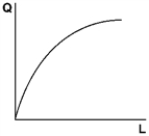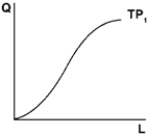A) the slope of the total output curve at the relevant point.
B) the negative of the slope of the total output curve at the relevant point.
C) the slope of the line connecting the origin with the relevant point on the total output curve.
D) the negative of the slope of the line connecting the origin with the relevant point on the total output curve.
F) All of the above
Correct Answer

verified
Correct Answer
verified
Multiple Choice
Suppose electricity (E) can be produced with coal (C) or gas (G) to operate steam turbines (T) .Suppose gas is more efficiently burned than coal but that they are otherwise perfect substitutes.E = min((G + .5C) ,T) . The isoquants between gas and coal will be
A) hyperbolas
B) quarter circles
C) straight lines
E) All of the above
Correct Answer

verified
Correct Answer
verified
Multiple Choice
A firm is defined as
A) a president,some vice presidents,and some employees.
B) any organization that wants to make a profit.
C) any accumulation of productive assets.
D) any organization that turns inputs into outputs.
F) None of the above
Correct Answer

verified
Correct Answer
verified
Multiple Choice
The marginal rate of technical substitution of labor for capital measures
A) the amount by which capital input can be reduced while holding quantity produced constant when one more unit of labor is used.
B) the amount by which labor input can be reduced while holding quantity produced constant when one more unit of capital is used.
C) the ratio of total labor to total capital.
D) the ratio of total capital to total labor.
F) None of the above
Correct Answer

verified
Correct Answer
verified
Multiple Choice
A firm's rate of technical substitution is represented graphically by
A) the slope of the line connecting the origin with the relevant point on the isoquant.
B) the negative of the slope of the line connecting the origin with the relevant point on the isoquant.
C) the slope of the isoquant at the relevant point.
D) the negative of the slope of the isoquant at the relevant point.
F) C) and D)
Correct Answer

verified
Correct Answer
verified
Multiple Choice
Graphically,the average productivity of labor would be illustrated by the slope of the marginal productivity curve at the relevant point.
A) the slope of the total product curve at the relevant point.
B) the slope of the marginal productivity curve at the relevant point.
C) the negative of the slope of the marginal productivity curve at the relevant point.
D) the slope of the chord connecting the origin with the relevant point on the total output curve.
F) B) and C)
Correct Answer

verified
Correct Answer
verified
Multiple Choice
If Q = K1/3L2 the MPK is
A) constant
B) diminishing
C) increasing
E) None of the above
Correct Answer

verified
Correct Answer
verified
Multiple Choice
If Q = K1/3L2 the MPL is
A) constant
B) diminishing
C) increasing
E) A) and B)
Correct Answer

verified
Correct Answer
verified
Multiple Choice
A rise in the average productivity of labor
A) always reflects technical progress.
B) reflects technical progress if other input usage hasn't changed.
C) reflects technical progress only if labor input hasn't changed.
D) reflects technical progress only if the quantity of output is increased.
F) A) and B)
Correct Answer

verified
B
Correct Answer
verified
Multiple Choice
A technical innovation in the production of automobiles by Ford Motor Company's for 1 million cars per year would necessarily
A) shift the "1 million car" isoquant away from the origin.
B) shift the "1 million car" isoquant toward the origin.
C) cause 1 million cars to be produced with more capital and less labor.
D) cause 1 million cars to be produced with more labor and less capital.
F) None of the above
Correct Answer

verified
Correct Answer
verified
Multiple Choice
 With a quadratic production with fixed capital Q = A + BL + CL2 and the shape shown above,B is
With a quadratic production with fixed capital Q = A + BL + CL2 and the shape shown above,B is
A) positive.
B) zero.
C) negative and less than C.
D) negative and greater than C.
F) B) and C)
Correct Answer

verified
Correct Answer
verified
Multiple Choice
The marginal physical product of labor is defined as
A) a firm's total output divided by total labor input.
B) the extra output produced by employing one more unit of labor while allowing other inputs to vary.
C) the extra output produced by employing one more unit of labor while holding other inputs constant.
D) the extra output produced by employing one more unit of capital while holding labor input constant.
F) A) and B)
Correct Answer

verified
Correct Answer
verified
Multiple Choice
If Q = K1/2L1/2 the MPL is
A) constant
B) increasing
C) diminishing
E) All of the above
Correct Answer

verified
Correct Answer
verified
Multiple Choice
 With a quadratic production with fixed capital Q = A + BL + CL2 and the shape shown above,A is
With a quadratic production with fixed capital Q = A + BL + CL2 and the shape shown above,A is
A) positive and greater than B.
B) positive and less than B.
C) zero.
D) negative.
F) C) and D)
Correct Answer

verified
C
Correct Answer
verified
Multiple Choice
If Q = K2L2 the MPL is
A) constant
B) diminishing
C) increasing
E) All of the above
Correct Answer

verified
Correct Answer
verified
Multiple Choice
If production is given by Q = KL,doubling both inputs
A) more than doubles output.
B) exactly doubles output.
C) increases output but does not double it.
D) leaves output unchanged.
F) All of the above
Correct Answer

verified
Correct Answer
verified
Multiple Choice
The production function
A) exhibits constant returns to scale and constant marginal productivities for K and L.
B) exhibits diminishing returns to scale and diminishing marginal productivities for K and L.
C) exhibits constant returns to scale and diminishing marginal productivities for K and L.
D) exhibits diminishing returns to scale and constant marginal productivities for K and L..
F) C) and D)
Correct Answer

verified
C
Correct Answer
verified
Multiple Choice
 With a cubic production with fixed capital Q = A + BL + CL2 + DL3 and a shape shown above,C is
With a cubic production with fixed capital Q = A + BL + CL2 + DL3 and a shape shown above,C is
A) positive.
B) zero.
C) negative and less than D.
D) negative and greater than D.
F) B) and C)
Correct Answer

verified
Correct Answer
verified
Multiple Choice
If,as a result of doubling all its inputs,a firm can more than double its output,the firm's production function exhibits
A) constant returns to scale.
B) increasing returns to scale.
C) decreasing returns to scale.
D) increasing marginal productivity to at least one input.
F) A) and D)
Correct Answer

verified
Correct Answer
verified
Multiple Choice
A fixed-proportion production function has isoquants that are
A) almost flat (i.e.,the isoquants are almost straight lines) .
B) L-shaped.
C) normally shaped (rectangular hyperbolas) .
D) None of the above.
F) A) and B)
Correct Answer

verified
Correct Answer
verified
Showing 1 - 20 of 36
Related Exams